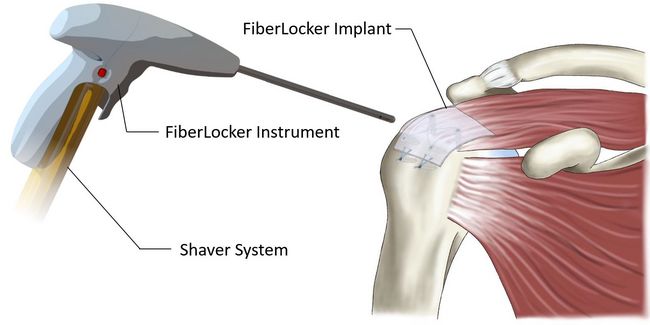Research in Orthopedics
A New Benchmark in Shoulder Surgery with Innovative Fiberlock Technology
The novel technology for suture-free surgery of rotator cuff repair has become reality. After four years of research and development in collaboration with the Balgrist Shoulder Team and start-up ZuriMED, this unique concept method has demonstrated its potential in an initial clinical indication.
Prof. Dr. Dominik Meyer (who unfortunately passed away on 12/15/2019) envisioned an alternative to surgical suturing with needle and thread. A globally unique concept method, which the researchers call “Surgical-Fiberlock Technology”, represents a paradigm shift for surgery. The technology directly addresses the key challenge in modern soft tissue surgery—reliable closure of soft tissue in order to regain stability and function. After four years of research and development by the Balgrist start-up
ZuriMED Technologies AG, “Surgical-Fiberlock Technology” has become reality in an initial clinical indication.
ZuriMED has further developed Prof. Meyer's concept of suture-free surgery for rotator cuff repair in collaboration with the Balgrist Shoulder Team. Rotator cuff tears present a major socioeconomic burden that is exacerbated by high rates of retear after repair surgery. The reasons for unsatisfactory postsurgical healing are multi-faceted, including biomechanical, biological, and technical obstacles to success. Mechanical weakness at the suture-tendon interface is widely viewed as a particularly critical factor, and patch augmentation of this interface has emerged as an active area of research and development. When compared with current patch augmentation repair techniques it is expected that the FiberLocker® Implant and Instrument will make the surgery faster, more reproducible, and result in a stronger repair. These aspects combine to make the technology a real orthopedic breakthrough. A large number of biomechanical tests, simulations, and arthroscopic investigations have been carried out at the Balgrist Campus, which is ideally equipped for this purpose.
Several pre-clinical studies have been successfully performed in close collaboration with an interdisciplinary team of surgeons, engineers, regulatory aff airs specialists, and other scientists. The outcomes validate the initial hypothesis that the innovative technique surpasses traditional suturing methods in mechanical fixation strength, while also maintaining consistent application across surgeons of differing expertise levels. In a subsequent research project, Prof. Dr. Wieser and his team conducted a cadaver study within a simulated operating room environment, utilizing an arthroscopic rotator cuff repair technique. This study focused on comparing the time required to implant the FiberLocker® Implant with that for commercially available synthetic patch, which was attached to the tendon via suturing. Results demonstrated a significant decrease in the surgical time necessary for patch implantation for the FiberLocker® Implant group. This decrease in surgical duration not only minimizes the risk of complications associated with anesthesia but also could result in considerable savings with regard to operating room expenses and postoperative care.
In order to collect the last safety endpoints before the novel technology can be used in humans, a project funded by Innosuisse was initiated in collaboration with the shoulder team, the laboratory of orthopedic biomechanics, and the industrial partner ZuriMED. In this project, the research team aims to demonstrate the strong value proposition and safety of the fi rst medical device that incorporates the breakthrough innovation in a controlled animal study in collaboration with the Musculoskeletal Research Unit of the University of Zurich. The controlled animal study follows strict GLP (Good Laboratory Practice) requirements in line with established study protocols to provide decisive scientific evidence for all investigated endpoints. In addition to various scientific collaborations with renowned partners from research and industry, the project team aims to initiate a first clinical trial to perform clinical testing of the technology and to bring it onto the market soon.
Fiberlock-Innovation in der Schulterchirurgie
Ein weltweit einzigartiges Konzeptverfahren, das die Forschung Surgical-Fiberlock Technology nennt, stellt einen Paradigmenwechsel in der Chirurgie dar. Die Technologie setzt direkt an der zentralen Herausforderung der modernen Weichteilchirugie an - dem zuverlässigen Verschluss von Weichteilen zur Wiederherstellung von Stabilität und Funktion.
Nach vier Jahren Forschung und Entwicklung durch das Balgrist.-Start-up ZuriMED Technologies AG in enger Zusammenarbeit mit dem Schulterteam der Universitätsklinik Balgrist ist die Surgical-Fiberlock Technology in einer ersten klinischen Indikation Realität geworden.
At a Glance
Surgical-Fiberlock Technology
Key Collaborators
Project lead: Prof. Dr. med. Karl Wieser
Dr. med. Bettina Hochreiter
Prof. Dr. Jess Snedeker
ZuriMED Team
Departments and Partners
Balgrist University Hospital, Shoulder and Elbow Surgery Unit
University of Zurich and ETH, Orthopaedic Biomechanics
ZuriMED Technologies AG
Clinical Relevance
In the long-term, a reduction in post-traumatic complications, rehabilitation times, pain and necessity for revision surgery are expected, resulting in a reduction of healthcare costs and an increase in the patient´s quality of life.
Further Information
> ZuriMED

